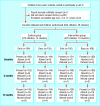Preventing childhood obesity by reducing consumption of carbonated drinks: cluster randomised controlled trial
- PMID: 15107313
- PMCID: PMC416601
- DOI: 10.1136/bmj.38077.458438.EE
Preventing childhood obesity by reducing consumption of carbonated drinks: cluster randomised controlled trial
Erratum in
- BMJ. 2004 May 22;328(7450):1236
Abstract
Objective: To determine if a school based educational programme aimed at reducing consumption of carbonated drinks can prevent excessive weight gain in children.
Design: Cluster randomised controlled trial.
Setting: Six primary schools in southwest England.
Participants: 644 children aged 7-11 years.
Intervention: Focused educational programme on nutrition over one school year.
Main outcome measures: Drink consumption and number of overweight and obese children.
Results: Consumption of carbonated drinks over three days decreased by 0.6 glasses (average glass size 250 ml) in the intervention group but increased by 0.2 glasses in the control group (mean difference 0.7, 95% confidence interval 0.1 to 1.3). At 12 months the percentage of overweight and obese children increased in the control group by 7.5%, compared with a decrease in the intervention group of 0.2% (mean difference 7.7%, 2.2% to 13.1%).
Conclusion: A targeted, school based education programme produced a modest reduction in the number of carbonated drinks consumed, which was associated with a reduction in the number of overweight and obese children.
Figures
Comment in
-
Childhood obesity and consumption of fizzy drinks: diet is not that important in obesity.BMJ. 2004 Jul 3;329(7456):54. doi: 10.1136/bmj.329.7456.54. BMJ. 2004. PMID: 15231638 Free PMC article. No abstract available.
-
Childhood obesity and consumption of fizzy drinks: play outside to reduce childhood obesity.BMJ. 2004 Jul 3;329(7456):54. doi: 10.1136/bmj.329.7456.54-a. BMJ. 2004. PMID: 15231639 Free PMC article. No abstract available.
-
Childhood obesity and consumption of fizzy drinks: commercial interests have important role.BMJ. 2004 Jul 3;329(7456):54. doi: 10.1136/bmj.329.7456.54-b. BMJ. 2004. PMID: 15231640 Free PMC article. No abstract available.
-
A school based programme to reduce carbonated drink consumption reduced obesity in children.Evid Based Nurs. 2004 Oct;7(4):105. doi: 10.1136/ebn.7.4.105. Evid Based Nurs. 2004. PMID: 15487081 No abstract available.
References
-
- Matayka K. Managing obesity in children. Obes Pract 2002;4(2): 2-6.
-
- Goran MI. Metabolic precursors and effects of obesity in children: a decade of progress, 1990-1999. Am J Clin Nutr 2001;73: 158-71. - PubMed
-
- Ludwig DS, Peterson KE, Gortmaker SL. Relation between consumption of sugar-sweetened drinks and childhood obesity: a prospective, observational analysis. Lancet 2001;357: 505-8. - PubMed
-
- Harnack L, Stang J, Story M. Soft drink consumption among US children and adolescents: nutritional consequences. J Am Diet Assoc 1999;99: 436-41. - PubMed
-
- Gregory J, Lowe S. National diet and nutrition survey: young people aged 4 to 18 years. London: Stationery Office, 2000.
Publication types
MeSH terms
LinkOut - more resources
Full Text Sources
Medical


